We sacrificed working moms to survive the pandemic; it’s time to share the burden

I want to assert this from the get-go: All motherhood is full-time motherhood and full-time work. Some of us who work outside of the home just happen to have an additional full-time job as well.
As COVID-19 vaccinations continue and society begins reopening, our eyes will be drawn to the things we get to experience again, like kids in schools and our work colleagues at desks. But many of those long-empty desks will not be filled with the working mothers who were forced out of their jobs during the pandemic.
It’s no secret that working moms have been some of the hardest hit with significant stress and responsibilities over the past year, especially mothers who are first responders or at a higher risk for contracting COVID-19. But what do we do with the moms who have somehow made it a full calendar year balancing full-time work and full-time motherhood? What are the new expectations? Can we actually learn something about what working women need moving forward?
Workplaces must respond
For both the mothers who held onto jobs by their fingernails and those who were forced to let go, let’s start with what we know.
On one hand, many traditional office jobs pivoted successfully to remote jobs, sometimes by working after hours and outside prescribed office hours. Sure, that work has been possible with copious amounts of caffeine (or wine, take your pick), cobbled together child care and managers who were forced to accept flexibility in the wake of the pandemic. But the work has, for the most part, been done. According to a recent Mercer study, productivity was the same as or higher than it was before the pandemic in 94% of 800 companies surveyed.
(Photo: Getty Images)
I have been one of the lucky ones. I work in a small office with three other women, two of whom are mothers. When my office closed in March 2020, along with my workplace-based child care, it was understood among the team that a great balancing act would begin.
Make equality a reality: There’s no deadline on women’s equality. Add the Equal Rights Amendment to the Constitution.
From “I can hop on Zoom at noon when the baby goes down” to “let me brainstorm while I pick up my daughter from dance,” our office embraced and sympathized with the new chaotic juggling act. For months, I took conference calls on speakerphone so I could change diapers at the same time. After dinner, bath time and bedtime, I’d log back on for several hours to catch up on the meetings I had to miss. We all just made it work. But many friends and colleagues outside of such an understanding structure haven’t been so lucky.
Drastic she-cession
Underneath the promising data, women have been martyred on the altar of productivity. According to McKinsey & Co., women have accounted for nearly 56% of workforce exits since the start of the pandemic despite making up 48% of the workforce. Last September, with the debate over in-person/remote schooling raging, an analysis of U.S. Bureau of Labor Statistics figures found that nearly 80% of the 1.1 million people who exited the labor force were women. These declines hit Black, Latina and Asian women the hardest.
This is not a coincidence, and it’s also not the full picture. Unemployment data alone cannot capture distinct reasons behind this exodus. We must include the high cost of child care, the prioritization of men’s jobs over women’s, and inflexible work structures that overburden mothers grappling with the unseen toll of unpaid care: the cooking, cleaning and daily care of children that women are more likely to undertake than men. In addition, the economic recovery for women and those with lower educational attainment or income is likely to lag behind counterparts.
Cuomo moment: We work in New York government. Sexual harassment in Albany is an open secret.
Beyond financial and employment crises, the pandemic created a deeper mental health crisis among mothers, both working and otherwise. Rep. Grace Meng, D-N.Y., said, “Moms throughout America are screaming out for help, but they sometimes feel like they are screaming into an echo chamber.”
The task of both working and “mom-ing” through COVID-19 has many mothers questioning the value of a 9-5 office, beyond the actual dollars-and-cents value, that doesn’t consider the emotional and mental well-being of its employees.
Learning from the crash
So what do we do with post-COVID working mothers? What is the strategy for helping those attempting to return to work following the greatest public health crisis of our lifetimes with wisdom and grace?
The first thing we do is validate the strain put upon women to stay the course. We knew that women would likely still step into the role of sacrificial lamb, whittling down in-office hours or stepping back completely for the good of their partners’ careers and their children’s education, not to mention serving as caretaker to vulnerable and aging parents. How did we know? Because that’s just what women do.
Adria Richmond in Dallas, Texas, in March 2020. (Photo: Family handout)
Whenever there is a gap that needs bridging — from women filling the World War II workforce to the data showing women give more frequently than men to humanitarian causes regardless of their income — research suggests that women are more effective leaders during a crisis. And that’s one of the great ironies of the “she-cession”: In order to lead, women have stepped back.
Once we move past acknowledgement of the disservice that has been done to women’s economic prospects, reversing gains from the past decade, we can begin to form a plan. Here are three clear pathways:
►First, child care assistance programs should match parents with local, affordable and high-quality child care options. American child care options have long been scrutinized for being outrageously expensive and exclusive while also employing workers at a wage that keeps them around the poverty line. Americans have long resisted a universal child care option in part because there is a disconnect between ideals and reality when it comes to women in the workforce.
Despite the strides made toward women’s equality, America still struggles with the moral argument that women should be the ones to take care of the children. On top of that, over 1 in 4 child care centers still remained closed in this country as of last December. Until high-quality child care is made more readily available to the parents who desire it, women who lost positions during the pandemic will be hard pressed to return to the office.
Investment in local, high-quality child care will certainly help.
►Second, we need a nationwide expansion of women-focused “returnships” — programs that can be introduced by large companies and organizations to reintroduce women who’ve fallen out of the workplace due to COVID-19 unemployment or any other reason related to their status as a mother.
JPMorgan Chase, Intuit, Accenture and more U.S. businesses have returnship programs offering supportive pathways back into the workforce after career breaks.
►The final pathway is the most important, and that is a dramatic reassessment of workplace norms that will reprioritize healthy work-life balance and consider hybrid modes of employment. This boils down to flexibility. Companies that successfully managed flexible work schedules before COVID-19 are the same companies who maintained productivity throughout the pandemic.
For far too long, we’ve expected America’s working mothers to either shut up and sit down behind the desk, keeping their concerns about family and child care and to themselves, or to take a knee and exit the workforce for full-time motherhood. It is possible that the coronavirus pandemic could bring about an unforeseen and welcome reevaluation of the American work-life balance and work structure, but only if we learn from the war on COVID-19 and work toward improving our society as a whole on the other side.
Adria Richmond is program specialist and lead designer of the Maguire Center for Ethics and Public Responsibility at Southern Methodist University in Dallas. While co-managing daily operations of the center, she is a mother of a 2-year old son.
You can read diverse opinions from our Board of Contributors and other writers on the Opinion front page, on Twitter @usatodayopinion and in our daily Opinion newsletter. To respond to a column, submit a comment to [email protected].
Source: Read Full Article


